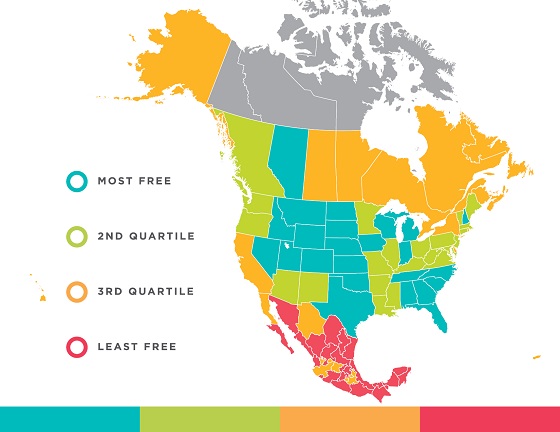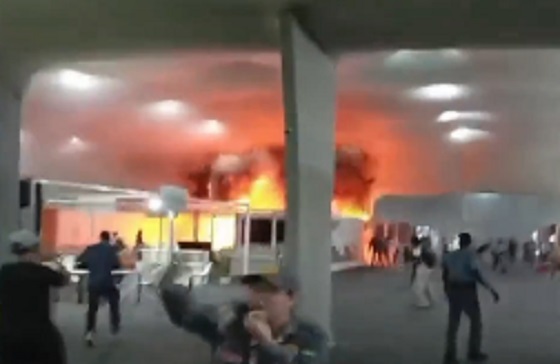Business
Alberta freest Canadian province, ranks 12th in North American; other provinces rank near bottom

From the Fraser Institute
By: Dean Stansel, José Torra, Matthew D. Mitchell and Ángel Carrión-Tavárez
Alberta is, once again, the Canadian province with the highest level of economic freedom, while most other provinces rank in the bottom half in the annual Economic Freedom of North America report, published today by the Fraser Institute, an independent, non-partisan, public policy think-tank.
Individuals have more economic freedom when they are allowed to make more of their own economic decisions such as what to buy, where to work and how to start and run a business. And research shows that economic freedom is fundamental to prosperity.
The report ranks the provinces and states individually for each country (Canada, the U.S. and Mexico). In addition, there is a fourth measure comparing and ranking all states and provinces, across all three countries. All of the rankings measure government spending, taxation, regulations and labour market restrictions using data from 2022 (the latest year of available comparable data).
“Higher taxes, higher levels of government spending and overly burdensome regulations continue to depress economic freedom across much of Canada, which makes it harder for individuals and businesses to thrive and create jobs,” said Matthew Mitchell, a senior fellow at the Fraser Institute and co-author of this year’s report.
In the ranking covering all three countries, which includes both federal and provincial government policies, Alberta is once again the highest-ranking Canadian province. It tied four U.S. states at 12th, having improved its ranking from 41st last year.
The next freest province is British Columbia, which ranks 43rd out of 93, followed by Ontario (47th), Saskatchewan (50th), Manitoba (53rd) and Quebec (54th).
The four Atlantic provinces— New Brunswick (57th), Prince Edward Island (58th), Nova Scotia (59th) and Newfoundland and Labrador (60th)—have the lowest levels of economic freedom among all provinces and U.S. states, only outranking the Mexican states and Puerto Rico. New Hampshire, once again, earned the overall top spot amongst all provinces and states in the rankings this year.
“The link between economic freedom and prosperity is clear: people who live in provinces or states that have comparatively lower taxation, lower government, sound regulatory regimes and more flexible labor markets tend, on average, to live happier, healthier and wealthier lives,” Mitchell said.
For instance, according to the latest report, total income in the freest jurisdictions grew 29 per cent after adjusting for inflation over the last decade, while in the least-free jurisdictions, total inflation adjusted income fell 13 per cent.
The Economic Freedom of North America report (co-authored by Dean Stansel, José Torra and Ángel Carrión-Tavárez) is an offshoot of the Fraser Institute’s Economic Freedom of the World index, the result of more than a quarter century of work by more than 60 scholars including three Nobel laureates.
Detailed tables for each country and subnational jurisdiction can be found at www.freetheworld.org.
Economic Freedom of North America 2024
- The indices in the Economic Freedom of North America 2024 measure the degree to which governments in North America permit their citizens to make their own economic choices.
- They include data from the 10 Canadian provinces, 50 US states, 32 Mexican states, and the US territory of Puerto Rico.
- In the all-government index—which takes account of federal as well as state/provincial policies—the most economically-free jurisdiction in North America is New Hampshire, followed by Idaho, Oklahoma and South Carolina tied for third, and Florida and Indiana tied for fifth.
- The lowest-ranking jurisdictions are all Mexican states. In last place is Ciudad de México. Above that is Colima, Campeche, Tamaulipas, and Zacatecas.
- Alberta is the highest-ranking Canadian province, tied for 12th place with Tennessee, South Dakota, Colorado, and Texas. The next-highest Canadian province is British Columbia, which is tied with Massachusetts, Minnesota, and New Mexico for 43rd.
- Average economic freedom across all 93 jurisdictions has fallen every year since 2017 and is now slightly above its all-time low.
- Incomes in the freest top 25 percent of North American jurisdictions were 21 times higher than in the least-free.
- From 2013 to 2022 the population of the freest US states grew 10 times faster and total employment grew three times faster than in the least-free states.
Business
New airline compensation rules could threaten regional travel and push up ticket prices

New passenger compensation rules under review could end up harming passengers as well as the country’s aviation sector by forcing airlines to pay for delays and cancellations beyond their control, warns a new report published this morning by the MEI.
“Air travel in Canada is already unaffordable and inaccessible,” says Gabriel Giguère, senior public policy analyst at the MEI. “New rules that force airlines to cover costs they can’t control would only make a bad situation worse.”
Introduced in 2023 by then-Transport Minister Omar Alghabra, the proposed amendment to the Air Passenger Protection Regulations would make airlines liable for compensation in all cases except those deemed “exceptional.” Under the current rules, compensation applies only when the airline is directly responsible for the disruption.
If adopted, the new framework would require Canadian airlines to pay at least $400 per passenger for any “unexceptional” cancellation or delay exceeding three hours, regardless of fault. Moreover, the definition of “exceptional circumstances” remains vague and incomplete, creating regulatory uncertainty.
“A presumed-guilty approach could upend airline operations,” notes Mr. Giguère. “Reversing the burden of proof introduces another layer of bureaucracy and litigation, which are costs that will inevitably be passed on to consumers.”
The Canadian Transportation Agency estimates that these changes would impose over $512 million in additional costs on the industry over ten years, leading to higher ticket prices and potentially reducing regional air service.
Canadians already pay some of the highest airfares in the world, largely due to government-imposed fees. Passengers directly cover the Air Travellers Security Charge—$9.94 per domestic flight and $34.42 per international flight—and indirectly pay airport rent through Airport Improvement Fees included on every ticket.
In 2024 alone, airport authorities remitted a record $494.8 million in rent to the federal government, $75.6 million more than the previous year and 68 per cent higher than a decade earlier.
“This new regulation risks being the final blow to regional air travel,” warns Mr. Giguère. “Routes connecting smaller communities will be the first to disappear as costs rise and they become less profitable.”
For instance, a three-hour and one minute delay on a Montreal–Saguenay flight with 85 passengers would cost an airline roughly $33,000 in compensation. It would take approximately 61 incident-free return flights to recoup that cost.
Regional air service has already declined by 34 per cent since 2019, and the added burden of this proposed regulation could further reduce connectivity within Canada. It would also hurt Canadian airlines’ competitiveness relative to U.S. carriers operating out of airports just south of the border, whose passengers already enjoy lower fares.
“If the federal government truly wants to make air travel more affordable,” says Mr. Giguère, “it should start by cutting its own excessive fees instead of scapegoating airlines for political gain.”
You can read the Economic Note here.
* * *
The MEI is an independent public policy think tank with offices in Montreal, Ottawa, and Calgary. Through its publications, media appearances, and advisory services to policymakers, the MEI stimulates public policy debate and reforms based on sound economics and entrepreneurship.
Business
Will the Port of Churchill ever cease to be a dream?

From Resource Works
The Port of Churchill has long been viewed as Canada’s northern gateway to global markets, but decades of under-investment have held it back.
A national dream that never materialised
For nearly a century, Churchill, Manitoba has loomed in the national imagination. In 1931, crowds on the rocky shore watched the first steamships pull into Canada’s new deepwater Arctic port, hailed as the “thriving seaport of the Prairies” that would bring western grain “1,000 miles nearer” to European markets. The dream was that this Hudson Bay town would become a great Canadian centre of trade and commerce.
The Hudson Bay Railway was blasted across muskeg and permafrost to reach what engineers called an “incomparably superior” harbour. But a short ice free season and high costs meant Churchill never grew beyond a niche outlet beside Canada’s larger ports, and the town’s population shrank.
False starts, failed investments
In 1997, Denver based OmniTrax bought the port and 900 kilometre rail line with federal backing and promises of heavy investment. Former employees and federal records later suggested those promises were not fully kept, even as Ottawa poured money into the route and subsidies were offered to keep grain moving north. After port fees jumped and the Canadian Wheat Board disappeared, grain volumes collapsed and the port shut, cutting rail service and leaving northern communities and miners scrambling.
A new Indigenous-led revival — with limits
The current revival looks different. The port and railway are now owned by Arctic Gateway Group, a partnership of First Nations and northern municipalities that stepped in after washouts closed the line and OmniTrax walked away. Manitoba and Ottawa have committed $262.5 million over five years to stabilize the railway and upgrade the terminal, with Manitoba’s share now at $87.5 million after a new $51 million provincial pledge.
Prime Minister Mark Carney has folded Churchill into his wider push on “nation building” infrastructure. His government’s new Major Projects Office is advancing energy, mining and transmission proposals that Ottawa says add up to more than $116 billion in investment. Against that backdrop, Churchill’s slice looks modest, a necessary repair rather than a defining project.
The paperwork drives home the point. The first waves of formally fast tracked projects include LNG expansion at Kitimat, new nuclear at Darlington and copper and nickel mines. Churchill sits instead on the office’s list of “transformative strategies”, a roster of big ideas still awaiting detailed plans and costings, with a formal Port of Churchill Plus strategy not expected until the spring of 2026 under federal–provincial timelines.
Churchill as priority — or afterthought?
Premier Wab Kinew rejects the notion that Churchill is an afterthought. Standing with Carney in Winnipeg, he called the northern expansion “a major priority” for Manitoba and cast the project as a way for the province “to be able to play a role in building up Canada’s economy for the next stage of us pushing back against” U.S. protectionism. He has also cautioned that “when we’re thinking about a major piece of infrastructure, realistically, a five to 10 year timeline is probably realistic.”
On paper, the Port of Churchill Plus concept is sweeping. The project description calls for an upgraded railway, an all weather road, new icebreaking capacity in Hudson Bay and a northern “energy corridor” that could one day move liquefied natural gas, crude oil, electricity or hydrogen. Ottawa’s joint statement with Manitoba calls Churchill “without question, a core component to the prosperity of the country.”
Concepts without commitments
The vision is sweeping, yet most of this remains conceptual. Analysts note that hard questions about routing, engineering, environmental impacts and commercial demand still have to be answered. Transportation experts say they struggle to see a purely commercial case that would make Churchill more attractive than larger ports, arguing its real value is as an insurance policy for sovereignty and supply chain resilience.
That insurance argument is compelling in an era of geopolitical risk and heightened concern about Arctic security. It is also a reminder of how limited Canada’s ambition at Churchill has been. For a hundred years, governments have been willing to dream big in northern Manitoba, then content to underbuild and underdeliver, as the port’s own history of near misses shows. A port that should be a symbol of confidence in the North has spent most of its life as a seasonal outlet.
A Canadian pattern — high ambition, slow execution
The pattern is familiar across the country. Despite abundant resources, capital and engineering talent, mines, pipelines, ports and power lines take years longer to approve and build here than in competing jurisdictions. A tangle of overlapping regulations, court challenges and political caution has turned review into a slow moving veto, leaving a politics of grand announcements followed by small, incremental steps.
Churchill is where those national habits are most exposed. The latest round of investment, led by Indigenous owners and backed by both levels of government, deserves support, as does Kinew’s insistence that Churchill is a priority. But until Canada matches its Arctic trading rhetoric with a willingness to build at scale and at speed, the port will remain a powerful dream that never quite becomes a real gateway to the world.
Headline photo credit to THE CANADIAN PRESS/John Woods
-

 Health2 days ago
Health2 days agoCDC’s Autism Reversal: Inside the Collapse of a 25‑Year Public Health Narrative
-

 Crime2 days ago
Crime2 days agoCocaine, Manhunts, and Murder: Canadian Cartel Kingpin Prosecuted In US
-

 Daily Caller2 days ago
Daily Caller2 days agoBREAKING: Globalist Climate Conference Bursts Into Flames
-

 Health2 days ago
Health2 days agoBREAKING: CDC quietly rewrites its vaccine–autism guidance
-

 Great Reset1 day ago
Great Reset1 day agoEXCLUSIVE: The Nova Scotia RCMP Veterans’ Association IS TARGETING VETERANS with Euthanasia
-

 Business13 hours ago
Business13 hours agoNew airline compensation rules could threaten regional travel and push up ticket prices
-

 Digital ID1 day ago
Digital ID1 day agoLeslyn Lewis urges fellow MPs to oppose Liberal push for mandatory digital IDs
-

 Energy2 days ago
Energy2 days agoHere’s what they don’t tell you about BC’s tanker ban










